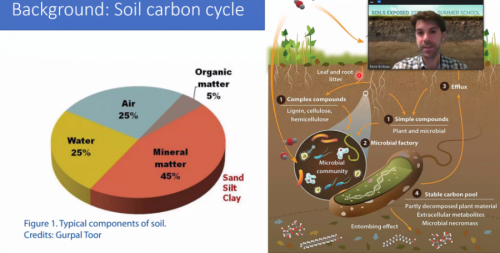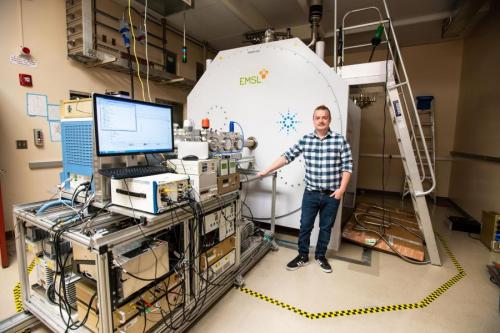Environmental Transformations and Interactions
Functional and Systems Biology
Computing, Analytics, and Modeling
Day 3: 2022 EMSL Summer School—Know Your Organic Matter
Identifying research plans, instrumentation, and data processing workflows

Day three of the 2022 EMSL Summer School focused on soil organic matter, including on the challenges facing research, available instrumentation for analysis, and data workflows. (Photo by Dawn Stringer | EMSL)
Approximately 5 percent of the world’s soil is made up of soil organic matter.
This is the material derived from living organisms like plants, animals, and microorganisms that goes back into the soil to decompose.
Soil organic matter, or SOM, plays a key role in a variety of environmental functions, including soil health, crop production, nutrient storage, and water infiltration. Additionally, SOM, ranging from leaf litter to biomass, can rapidly transform and can be used as a carbon or energy source. But soils around the world are diverse and contain different amounts of SOM, making this a challenging research area, says Rene Boiteau, an assistant professor in Oregon State University’s College of Earth, Ocean, and Atmospheric Sciences.
“Organic matter in soils improves water retention and aeration, holds nutrients, feeds microbes, and serves as one of the major carbon reservoirs on Earth,” Boiteau explains. “But we still don’t know most of the details of how it is created and transformed. This knowledge is important for determining whether the carbon and nutrients present in soil organic matter is accessible to plants, and what natural or human interventions would make it more or less available.“
Boiteau presented at day three of the five-day virtual 2022 EMSL Summer School: Soils Exposed! on approaches for studying SOM. Will Kew and Yuri Corilo, both from the Environmental Molecular Sciences Laboratory (EMSL), a Department of Energy, Office of Science user facility at Pacific Northwest National Laboratory (PNNL), walked attendees through available instrumentation for characterizing SOM and shared data processing workflows for natural organic matter and metabolomics.
Designing a SOM Experiment

Boiteau, an EMSL user who also holds a joint appointment with PNNL, has focused much of his research on characterizing SOM.
During his Summer School presentation, he outlined recommended steps for developing an experiment. He demonstrated the importance of choosing a tractable science question, identifying useful analytical methods, developing a sample set, and preparing samples for analysis.
He notes there are a variety of unknowns with SOM, which make it difficult to study, but ideal research experiments. These unknowns include molecular structure, soil depth, permafrost, physical heterogeneity, humic substances, fire-derived components, and soil microorganisms.
“We have an amazing opportunity to learn analyses for studying organic matter,” says Boiteau.
Mass Spectrometry for SOM

Understanding available instrumentation for characterizing SOM is key to developing the scientific question when designing an experiment, Boiteau says. Specifically, he references the importance of understanding the limitations of analytical methods. For example, liquid chromatography allows researchers to see a larger diversity and reduces ion suppression, but it offers a more limited range of organic molecules.
Kew, a chemist with EMSL’s Biomolecular Pathways Integrated Research Platform, gave an overview of the different types of instrumentation that can be used for molecular analysis of SOM, including high-resolution mass spectrometry, nuclear magnetic resonance, and liquid chromatography. All the instruments require SOM to be in a liquid state. These resources can also be used to characterize organic matter from water and in air, as well as in the role of nutrient cycling, carbon sequestration, droughts, floods, wildfire events, and other biogeochemical transformations.
“All of these biogeochemical transformations come into play when we’re thinking about not only the effects of these different events on the soil, but also probes for things that have happened in soils in the past,” Kew said.
According to Kew, the “gold standard” for organic matter analysis, particularly for complex samples, is the Fourier Transform Ion Cyclotron Resonance Mass Spectrometer (FTICR-MS). This instrument has a superconducting magnet like that of a MRI scanner, but the FTICR-MS magnet is 10 to 20 times stronger, he explains. FTICR is also not only a high-resolution instrument, but also measures all ions at once. Using a FTICR-MS requires careful control and optimization for high-quality spectra. EMSL is home to one of two of the world’s 21 Tesla FTICR mass spectrometers, which is considered a flagship mass spectrometer, Kew says.
SOM Research and Data Workflows
After Kew’s presentation on instrumentation, Corilo discussed the complexity of data related to organic matter. He points out that 80 percent of data-related molecular structure is uncharacterized.
“Strategies that are often used on proteomics and genomics are not feasible for the characterization of organic matter and metabolites,” says Corilo, a computational scientist with the Systems Modeling Integrated Research Platform. "There is this increased complexity of the different degradation pathways when the molecules or different biomass comes into contact with different environments.”
He provided details on the steps of processing data before presenting on an open software framework called CoreMS. The software architecture is designed to produce standardized, comprehensive molecular characterization. CoreMS also standardizes metadata and other data products to enable simulations and artificial intelligence and machine learning methods. A CoreMS data portal manages data resources and analysis, unifying processing and data visualization.
Opportunities to Study SOM at EMSL
Wednesday’s presentations also shed light on the availability of instrumentation and resources at user facilities like EMSL. Kew and Corilo encouraged attendees to get in contact with EMSL science area leaders, as well as EMSL Integrated Research Platform leaders, to explore how potential research could utilize EMSL instrumentation. They recommend looking for opportunities to write exploratory proposals to engage with user facility resources, a topic that will be covered in the student-only closed session this Friday.
“I think working with user facilities is a fantastic way to become exposed to many more types of instruments,” says Boiteau. “Obviously, EMSL is one of the top ways we can get access.”
Learn more about EMSL proposal call opportunities.
Get in touch with EMSL science area leaders and explore EMSL’s Integrated Research Platforms.
Watch all presentations from day three of 2022 EMSL Summer School.

